"Better Burgers" May 20, 2010 - Volume 2 - Issue 10
|
|
|
Closed May 24 - 30
to prepare for the
Spring Super Sale
 |
|
|
Fire up the Grill!
| A great burger on the grill
is hard to beat! The proxies found at fast food restaurants do
disservice to what a great hamburger can be. With warmer weather upon
us, it's time to move the kitchen outdoors and reap some great burger
flavors from the grill. 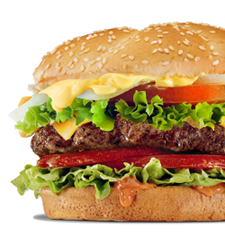 Mastering burgers on
the grill is a worthwhile, budget-minded endeavor. We've uncovered a
whole new world of burgers featuring great flavor and endless variety
that leaves us anything but deprived. The lessons learned about grilling
burgers translate well to other aspects of our grilling life, too. Mastering burgers on
the grill is a worthwhile, budget-minded endeavor. We've uncovered a
whole new world of burgers featuring great flavor and endless variety
that leaves us anything but deprived. The lessons learned about grilling
burgers translate well to other aspects of our grilling life, too.
IN THIS ISSUE,
we provide
an update on making better burgers by refreshing our knowledge of the
basics. With this foundation, we introduce some recipes with
embellishments and improvisational notions. And, what would a classic
burger be without ketchup and mustard? We'll share what we know about
these ubiquitous condiments, increase your grilling prowess with some
great tips, and conclude with three great-tasting burger recipes you can
enjoy tonight!
|
Spring Super Sale
| 
|
Spring Special
| 
|
|
|
|
Burger Fundamentals
| There's nothing to making a good burger, but
there are a few tricks to incorporate into your methodology that will
make for a better
burger, and, perhaps, inspire you to create your own signature burger.
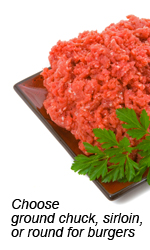 Choosing the Meat- Because burgers have the simplest of ingredients, choosing the meat
is a crucial decision. Traditional beef burgers can be made from chuck,
sirloin, or round cuts of beef. Chuck is a combination of meats from the
"waist and above" on a cow, sirloin is from the midsection, and round
is from the hip and upper back legs. When it comes to meat, fat equals
flavor. Not exactly what our nutritionists want to hear, but true. Chuck
tends to be about 80% lean and 20% fat. Sirloin weighs in at around 90%
lean, and round at around 85% lean. Buy meat that has a fresh, bright
color from a reputable source. Choosing the Meat- Because burgers have the simplest of ingredients, choosing the meat
is a crucial decision. Traditional beef burgers can be made from chuck,
sirloin, or round cuts of beef. Chuck is a combination of meats from the
"waist and above" on a cow, sirloin is from the midsection, and round
is from the hip and upper back legs. When it comes to meat, fat equals
flavor. Not exactly what our nutritionists want to hear, but true. Chuck
tends to be about 80% lean and 20% fat. Sirloin weighs in at around 90%
lean, and round at around 85% lean. Buy meat that has a fresh, bright
color from a reputable source.
Grinding
and Chopping - Ground meats are readily available at any grocer;
choose the cut and fat percentage you prefer for the situation.
Increasingly, individuals are choosing their own cuts of meat and
grinding them at home. This allows control over quality and composition.
You may use a grinder attachment on your mixer to accomplish this, or
use razor-sharp knives to chop the meat finely.
Shaping the Patties - Form patties
from the ground meat that hold together easily, while handling the meat
as lightly as possible. Use a kitchen scale to weigh equal portions of
ground meat; this will minimize handling. Avoid handling the meat too
much and smashing it together. 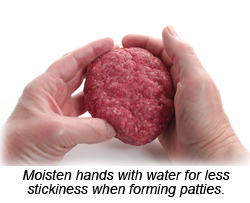 A
light texture will provide small spaces for the juices to collect
during grilling and eating. Use a mold or burger press to quickly
achieve uniformity. A
light texture will provide small spaces for the juices to collect
during grilling and eating. Use a mold or burger press to quickly
achieve uniformity.
Seasoning
the Meat - Most meats need nothing more than salt and pepper for
great flavor. Because salt withdraws juices from food, we tend to salt
just prior to grilling. However, if your burger is destined to have
other seasonings, they may be incorporated into the meat prior to
forming patties. Allow the burgers to chill so that the flavors blend
and the meat regains its coldness prior to grilling.
Grilling and Cooking - Cook burgers on
a medium-hot grill. Once heated, rub the grate with a paper towel
dipped in olive oil to help prevent sticking. Place the cold burgers on
the grill, cover, and allow to cook for about 2 minutes, then turn and
allow to finish grilling according to the size of the patty. The key to a
great burger is not pressing down on the burgers while cooking. This
forces the juices out of the meat instead of retaining moistness and
flavor.
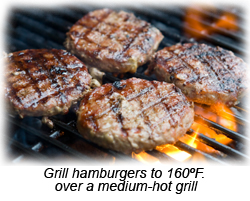 Testing Doneness - Being flat,
burgers are easy to estimate doneness. However, we always recommend
using an instant read thermometer when cooking any meat. Undercooking
meat is undesirable, but more often, there is a tendency to overcook
meat robbing the burger of flavor and yielding a dry result. A
thermometer provides confidence in the grilling experience and promotes
the best result possible. Cook hamburgers until the center reaches
160ºF. Testing Doneness - Being flat,
burgers are easy to estimate doneness. However, we always recommend
using an instant read thermometer when cooking any meat. Undercooking
meat is undesirable, but more often, there is a tendency to overcook
meat robbing the burger of flavor and yielding a dry result. A
thermometer provides confidence in the grilling experience and promotes
the best result possible. Cook hamburgers until the center reaches
160ºF.
Serving Fresh - As
hungry as you might be given the swirling aromas, allow the finished
burgers to set for a few minutes so that juices can be reabsorbed into
the meat. Use this waiting time to grill the buns to a perfect golden
toast.
|
Ketchup and Mustard
| Open nearly any refrigerator
in America and you'll find in the door shelves a container of ketchup
and at least one type of mustard. But what do we know about these
ubiquitous condiments?
 Ketchup tops the list
of condiments, no question. Originally, the word, ketchup, described any
number of sauces. The term's meaning settled on the tomato-based sauce
by the early 1800s. Henry J. Heinz developed today's ketchup sauce and
set the standard for flavor and texture by the turn of the 20th century. Ketchup tops the list
of condiments, no question. Originally, the word, ketchup, described any
number of sauces. The term's meaning settled on the tomato-based sauce
by the early 1800s. Henry J. Heinz developed today's ketchup sauce and
set the standard for flavor and texture by the turn of the 20th century.
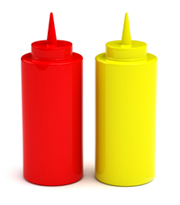 His secret was to use
ripe tomatoes, pickle them with vinegar, and then concentrate the
sauce. Ketchup is considered good if it is thick, does not separate,
and, of course, tastes great. The secret to ketchup's huge fan base lies
in its ingredients. Ketchup contains tomato, vinegar, sugar, salt,
spices, and herbs. This mélange of flavors hits all of our taste buds -
sweet, salty, sour, bitter, and the fifth taste, umami. With all
cylinders firing at once, no wonder ketchup registers pleasure in our
mouths. His secret was to use
ripe tomatoes, pickle them with vinegar, and then concentrate the
sauce. Ketchup is considered good if it is thick, does not separate,
and, of course, tastes great. The secret to ketchup's huge fan base lies
in its ingredients. Ketchup contains tomato, vinegar, sugar, salt,
spices, and herbs. This mélange of flavors hits all of our taste buds -
sweet, salty, sour, bitter, and the fifth taste, umami. With all
cylinders firing at once, no wonder ketchup registers pleasure in our
mouths.
 Mustard holds second
place on the post-grill table. While ketchup seems to be, well, ketchup,
mustard sports a host of personalities that project distinctly
different flavors and effects. All mustards start with the humble
mustard seed, the fruit of the mustard plant. Mustard seed or dry
mustard powder does not have any potency on its own, but when combined
with water or liquid, heat emerges. The cooler the liquid used in
mustard preparation, the hotter the mustard. Hot water breaks down the
heat component during mustard making and later during roasting or
grilling. Vinegar, water, and spice mixed with the ground mustard seed
complete the condiment. There are four common types of mustard each with
many variations: Mustard holds second
place on the post-grill table. While ketchup seems to be, well, ketchup,
mustard sports a host of personalities that project distinctly
different flavors and effects. All mustards start with the humble
mustard seed, the fruit of the mustard plant. Mustard seed or dry
mustard powder does not have any potency on its own, but when combined
with water or liquid, heat emerges. The cooler the liquid used in
mustard preparation, the hotter the mustard. Hot water breaks down the
heat component during mustard making and later during roasting or
grilling. Vinegar, water, and spice mixed with the ground mustard seed
complete the condiment. There are four common types of mustard each with
many variations:
|
Cooking with Fire
| Why do people grill?
Anthropologists might point to some primeval connection to fire, the
chemist might point to the Maillard reaction occurring during browning,
but a modern interpretation might land on the simplest of answers - it
tastes good! To enjoy your grilling life to the max, keep these ideas in
mind:
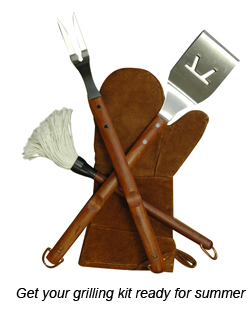 Keep the Grill Clean!- We can't emphasize this enough. A clean grill will allow your foods to
keep their true grilled flavors without any compromise from burnt
pieces, ash, or other leftovers from the last grilling session. Use a
wire brush to scrape away any stuck on food. Be religious in keeping
your grill clean and you'll be rewarded with great tasting food and a
long-lasting grill. Keep the Grill Clean!- We can't emphasize this enough. A clean grill will allow your foods to
keep their true grilled flavors without any compromise from burnt
pieces, ash, or other leftovers from the last grilling session. Use a
wire brush to scrape away any stuck on food. Be religious in keeping
your grill clean and you'll be rewarded with great tasting food and a
long-lasting grill.
Oil the
Grate - Once clean, oil the preheated grate with a paper towel
soaked with an oil of your choice and held by a pair of tongs. The thin
coat of oil will keep foods from sticking and simultaneously allow for
easier clean up later.
Expand
your Grilling Life - Explore burgers on the grill, but don't
forget all of the other foods that would benefit from the magic of the
grill. Master the tradition of meat on the grill with beef cuts, but
don't forget pork, chicken, turkey, and seafood. You may like to
experiment with less common meats such as buffalo, ostrich, emu, or
game. Vegetables on the grill are hard to match, as are grilled fruits.
Baskets, Skewers, Mats - A few key
tools can make your grilling explorations instantly more successful.
Grill baskets allow for small pieces of seafood or vegetables to be
grilled easily without any loss through the grate. Explore the many
skewers we have for kabob grilling; each has its distinct use and
advantage. Grilling mats, like grilling baskets keep food from falling
through the grate while allowing the fire and smoke to infuse into the
food. Mats are particularly useful for grilling fish and vegetables.
|
Smart Grilling Tips
| Tip #1:
Expand
your repertoire of burger buns - ditch the soft, fluffy breads and
choose breads with some heft, flavor, and interest. Here are a few
alternatives - ciabatta buns, baguettes, croissants, English muffins, or
any number of flat breads.
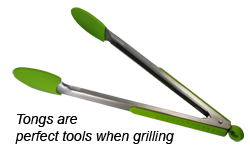 Tip #2:
Get
comfortable with using tongs when grilling. Tongs allow for all kinds of
handling motions with the advantage of long-handled distance. Tongs
have an advantage over long-handled forks; forks pierce the food
allowing juices to escape. Tip #2:
Get
comfortable with using tongs when grilling. Tongs allow for all kinds of
handling motions with the advantage of long-handled distance. Tongs
have an advantage over long-handled forks; forks pierce the food
allowing juices to escape.
Tip #3: Add olive oil to lean cuts of
ground meat for juiciness and flavor. This doesn't necessarily reduce
the overall fat content, but it does substitute a better, healthier type
of fat and optimizes the richness and moistness in the end result.
Tip
#4: When grilling kabobs use skewers that are flat. The flat
shape will
help keep the food from spinning when turning.
Tip #5: When shaping patties, moisten
your hands with water. This will help to keep the meat from sticking to
your hands and makes washing up easier.
|
Q & A's
|
 Q: How can I make a great
burger indoors? Q: How can I make a great
burger indoors?
A: If you live in an apartment, or if it's raining and your patio is
uncovered, a great burger is still accessible. Here are two common
methods for making indoor burgers: (1) Pan-Searing, and (2) Grill Pan.
When pan-searing a burger, heat a tablespoon of oil in a medium-high
skillet, add the burgers, cover for 2 minutes, turn, and complete the
cooking. A grill pan is used similarly with one exception, excess fat is
allowed to drain away from the frying meat due to the pan's ridges.
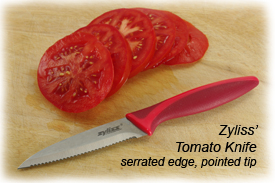 Q: How do I know when
my grill is hot enough for grilling burgers? Q: How do I know when
my grill is hot enough for grilling burgers?
A: Burgers usually require a
medium-hot grill. Hold your hand, palm down 4-5 inches above the grill.
If you can hold it there for about 4 seconds the heat is just about
right for burgers. If you need to pull away sooner, it's too hot; if you
can hold your hand there longer, it's too cool.
Q: What's the best way to get perfect tomato
slices for my burgers?
A:Choose a tomato that matches the size of your burgers and one that is
more meaty than juicy. Use a high quality serrated knife to slice the
tomatoes as thinly as you'd like. A classic tomato knife has a
razor-sharp serrated edge and a pointed tip for spearing and moving the
completed slices.
Q: What is
piccalilli?
A: Varying
by region, piccalilli is a relish of various chopped, pickled
vegetables. The veggies are often held together in a mustard-based sauce
and are a classic addition to mustard and ketchup on the condiment
tray. |
Cookbook Review
| Burger Bar by Hubert Keller
with Penelope Wisner. Photography by Bill Milne. Published by John Wiley
& Sons, Hoboken, NJ. Copyright 2009.
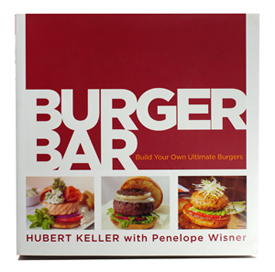 Who
knew burgers could be so interesting? This cookbook serves up a whole
new attitude for burgers that can be summed up in one word, flavor! Mr.
Keller and Ms. Wisner manage to take the humble burger and transform it
into the centerpiece with some serious flavor dynamics. They school us
in the essential basics, then propel us into the big world of delicious
variations. While the initial focus is with traditional beef versions,
the book broadens its appeal with pork, fowl, and seafood substrates.
The much maligned veggie burger is reinvented and duly elevated in its
appeal. The book concludes with great suggestions for sides, sauces, and
finales. The full color photographic illustrations start the mouth
watering upon first glance; the real thing that followed did not
disappoint. Try the three recipes below, then you'll be ready for
Keller's French-inspired Burger au Poivre, or the Brazilian Feijoada
Burger. Burgers have never been better! Who
knew burgers could be so interesting? This cookbook serves up a whole
new attitude for burgers that can be summed up in one word, flavor! Mr.
Keller and Ms. Wisner manage to take the humble burger and transform it
into the centerpiece with some serious flavor dynamics. They school us
in the essential basics, then propel us into the big world of delicious
variations. While the initial focus is with traditional beef versions,
the book broadens its appeal with pork, fowl, and seafood substrates.
The much maligned veggie burger is reinvented and duly elevated in its
appeal. The book concludes with great suggestions for sides, sauces, and
finales. The full color photographic illustrations start the mouth
watering upon first glance; the real thing that followed did not
disappoint. Try the three recipes below, then you'll be ready for
Keller's French-inspired Burger au Poivre, or the Brazilian Feijoada
Burger. Burgers have never been better!
|
Better Burger Recipes
| Recipes excerpted from Burger Bar
by Hubert Keller with Penelope Wisner. Published by John Wiley &
Sons, Hoboken, NJ. Copyright 2009. Reprinted with permission of the
publisher. All rights reserved.
Black Jack Burgers
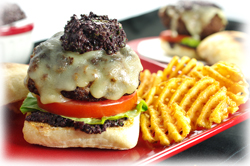 View and Print View and Print
Full bodied in stature
and in flavor, this burger delivers. Choose some good chuck, season, and
grill. The "black" in Black Jack comes from the delicious olive
tapenade, and the "jack" comes from a thick slice of Monterey Jack
cheese. The combination makes for a hat trick certain to win over the
entire house. The extra tapenade was delicious the next morning on a
lightly toasted baguette.
Blue Cheese-Stuffed Bacon Sliders
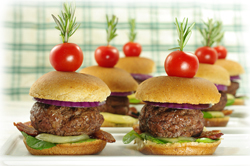 View and Print View and Print
Perfectly packaged,
blue cheese unites two of its favorites, beef and pears, together in
these tasty stacks. Slider-sized, these burgers pack tons of flavor into
just a few bites. The caramelized pears seem an unlikely addition, but
turn out to be an essential flavor. The blue cheese melts nicely
permeating the burger with a juicy dimension. The sliders made for a
dynamite presentation on a tray served tapas style.
Seared Tuna Burgers
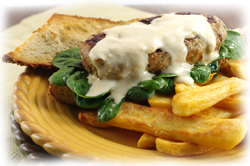 View and Print View and Print
Not every burger needs
to be a beef burger. This fresh tuna burger with its Asian flavor
influences will have you converted at first bite. Sesame oil and ginger
provide plenty of personality for the tuna. The Sesame Vinaigrette is a
keeper combination of ingredients that is not only the perfect condiment
for the tuna burgers, but is great on greens, easy to make, and a
pizzazz-y dressing for all kinds of grilled foods.
|
|
Fire up the grill and make a better burger!
|
|
Lorraine, Katie, and all of the Staff at Beyond Pots and Pans
|
|
|
|
|